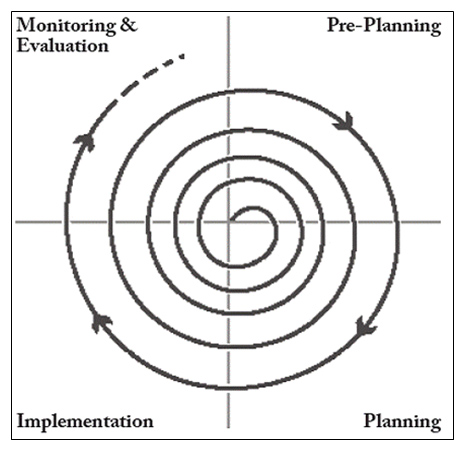COMPREHENSIVE COMMUNITY PLAN
Comprehensive community planning is a process that engages all community members in planning and implementing the long-term vision of their community. It includes the development of objectives, goals, and a plan of action to work towards fulfilling the vision. It can also include the development of mission, vision, and values statements, if they haven’t already been developed.
The Comprehensive Community Plan is a document that includes all the elements important to a community. It’s a plan that is created by the community for the community and is meant to be a high-level guide for community goals and dreams.
Together, the community addresses everything from economic development, social development, environmental management, governance, culture and language, and sustainability as a central principle.
 This image, borrowed from INAC’s Comprehensive Community Planning Handbook represents the continuous, non-linear process of planning.
This image, borrowed from INAC’s Comprehensive Community Planning Handbook represents the continuous, non-linear process of planning.
There are four stages to the planning process and community involvement is essential for all stages.
The stages are as follows:
I. Pre-planning Stage
- Determine community readiness
- Prepare a budget and identify potential funding
- Form a planning committee
- Perform research on background, other CCPs, planning, community engagement techniques, facilitation, etc
- Develop a work plan
II. Planning Stage
- Perform more research
- Complete community analysis
- If not already done, create vision and values statements
- Develop a comprehensive strategic framework
- Set objectives and goals
- Identify activities and projects
- Create an implementation strategy
III. Implementation Stage
- Prioritize actions for policies, programs and projects
- Create a project management team
- Obtain necessary approvals and establish good communications and reporting plans
- Identify potential partners to support the project
- Identify funding and other resources
- Create work plans, budgets, feasibility studies and business plans
- Manage the projects
- Learn lessons, develop best practices and celebrate successes
- Maximize community training mentorship, capacity-building and employment
IV. Monitoring and Evaluation Stage
- Analyze results
- Review and recommend
- Revise and update
- Share and celebrate your community’s accomplishments
Mamalilikulla First Nation started the CCP process in January 2017. One of the burning issues the membership has is that of having no permanent community. Without a reserve base, our membership is scattered mainly throughout Vancouver Island and the Lower Mainland. Chief and Council met with the membership from January thru March in the following communities:
- Campbell River
- Port Hardy
- Alert Bay
- Nanaimo
- Victoria, and
- Vancouver
 The meetings were engaging and encouraging, with introductions made and family histories discussed. During that time, we also had a logo contest and Bruce Alfred was the lucky winner, giving us this beautiful logo to represent Mamalilikulla First Nation.
The meetings were engaging and encouraging, with introductions made and family histories discussed. During that time, we also had a logo contest and Bruce Alfred was the lucky winner, giving us this beautiful logo to represent Mamalilikulla First Nation.
Chief Sumner is very dedicated to rebuilding the community, and with help from INAC funding, Mamalilikulla has continued the CCP process by contracting a CCP Coordinator to facilitate the next stages in the process. We are currently in Stages I & II, having held one series of community engagement sessions in each of the above locations, which experienced some very good engagement.
Through community gatherings and one-on-one meetings, we will address everything and hear what everyone in the community has to say. We will do our best to introduce ourselves to everyone and hear from everyone in the community in one way or another and we will do our best to keep everyone updated on the process, by way of newsletters, website updates, Facebook posts, community engagement sessions and one-on-one meetings.